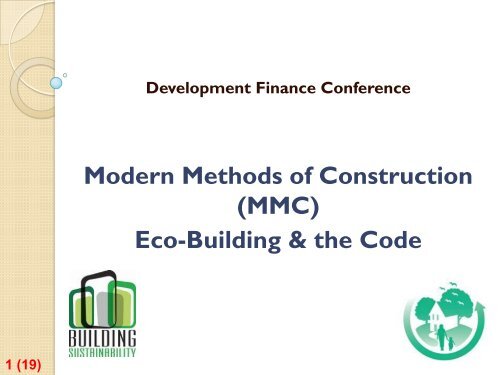Introduction to MMC & Eco Construction – Tim Doherty, Buildstore
Introduction to MMC & Eco Construction – Tim Doherty, Buildstore
Introduction to MMC & Eco Construction – Tim Doherty, Buildstore
You also want an ePaper? Increase the reach of your titles
YUMPU automatically turns print PDFs into web optimized ePapers that Google loves.
Development Finance Conference<br />
Modern Methods of <strong>Construction</strong><br />
(<strong>MMC</strong>)<br />
<strong>Eco</strong>-Building & the Code<br />
1 (19)
Bench Mark <strong>–</strong> Traditional Build?<br />
Traditional Build in the UK - Often referred <strong>to</strong> as<br />
a ‘brick & block’ cavity wall, but in reality the first<br />
cavity wall constructed as we know it was not in<br />
evidence until the early 1920’s!<br />
(Cavity not insulated at that time).<br />
‘Traditional’ <strong>–</strong> Typical Example:<br />
‣ Brick or S<strong>to</strong>ne External Skin<br />
‣ 50mm Cavity (Non Insulated Traditionally)<br />
‣ Block Inner Skin<br />
‣ Clay, Concrete or Slate Tiled Roof<br />
‣ Internal Loadbearing Concrete Block Walls<br />
(Foundations and Ground Slabs not Considered for this discussion)<br />
2 (19)
3 (19)<br />
The Code for Sustainable Homes:
The Code for Sustainable Homes:<br />
Categories<br />
1. Energy & CO² emissions (spec)<br />
2. Water consumption (120 <strong>to</strong> 105 <strong>to</strong> 80 litres/person/day) (spec)<br />
3. Environmental impact of materials <strong>–</strong> responsible sourcing (spec)<br />
4. Surface water run off (spec)<br />
5. Waste management (design)<br />
6. Pollution (spec & design)<br />
7. Health and well being (spec & design)<br />
8. Management (process)<br />
9. <strong>Eco</strong>logy (design & process)<br />
4 (19)
Passive House Standard (PassivHaus):<br />
Passive buildings rely on high levels of insulation and tight control over<br />
airtightness <strong>–</strong> Buildings built <strong>to</strong> this standard can run effectively on lowvolume<br />
heat recovery ventilations systems required <strong>to</strong> maintain air quality.<br />
5 (19)
Definitions [1-3]: <strong>MMC</strong> & <strong>Eco</strong> Building<br />
1(6). Offsite refers <strong>to</strong> modern methods of<br />
construction which has predominantly been<br />
manufactured & assembled in a fac<strong>to</strong>ry<br />
controlled environment<br />
2(6). Onsite refers <strong>to</strong> modern<br />
methods of construction which<br />
brings <strong>to</strong>gether systems or<br />
components which are<br />
predominantly assembled onsite<br />
3(6). <strong>Eco</strong> Building (Green Building) refers <strong>to</strong><br />
construction methods both ‘modern’ & ‘old’ that<br />
embrace ecological & environmental building<br />
techniques, which includes ‘Natural Buildings’<br />
6 (19)
[4-6] Systems, Components & Materials:<br />
4(6). Systems - define methods of building or techniques<br />
which comprise the majority of a building thus defining it as a<br />
system rather than a component alone:<br />
<strong>Tim</strong>ber Frame System, Steel Frame System, etc.<br />
5(6). Components - parts of a building made up from singular<br />
or multiple materials which can be offsite or site assembled and<br />
can be used in a variety of ‘System Types’<br />
I Joists, Roof Trusses, SIP’s Roof Cassettes, etc.<br />
6(6). Materials - individual elements which combine<br />
<strong>to</strong> make component parts or full systems. ‘New<br />
Materials’ are being designed as single elements,<br />
components & the basis for full Building Systems<br />
7 (19)
<strong>MMC</strong> [1] <strong>–</strong> Offsite / Benefits:<br />
The ‘Eternal Triangle’ states that you cannot alter any one<br />
facet without it directly affecting the other two.<br />
<br />
<br />
<br />
Quicker = More cost or less quality<br />
Cheaper = Lower quality<br />
Higher Quality = More time and money<br />
Quality<br />
Offsite Production Benefits =<br />
Increased Quality and Reduced <strong>Tim</strong>e & Cost.<br />
1) Reduced Prelims due <strong>to</strong> shorter time on site<br />
2) Reduced Project Management costs<br />
3) Reduced Professional Fees<br />
4) Reduced Programme <strong>Tim</strong>es<br />
5) Reduced Defects and Rework due <strong>to</strong> high first time quality<br />
6) Reduced Wastage on site<br />
7) Reduced Weather Dependency<br />
8) Increased Procurement Strategies<br />
9) Reduced Reliance on Transient Labour<br />
10) Increased Health and Safety on Site<br />
8 (19)
9 (19)<br />
<strong>MMC</strong> [1] <strong>–</strong> Offsite Systems (Volumetric & Panelised):<br />
1) <strong>Tim</strong>ber Frame:<br />
• Closed Cell<br />
• Filled Cell<br />
• Open Cell<br />
2) Lightweight Steel Frame<br />
• Closed Cell<br />
• Open Cell<br />
• Braced Frame<br />
3) Structurally Insulated Panels (SIP’s)<br />
4) Semi SIP’s (Structural Insulation &<br />
Frame)<br />
5) Multi-layered Engineered <strong>Tim</strong>ber (Solid)<br />
6) Precast Concrete Panels
10 (19)<br />
Precast Concrete & SIP’s Panels
<strong>MMC</strong> [2] <strong>–</strong> Onsite Systems:<br />
Onsite Systems comprise many methods which benefit from the use of<br />
modern materials. As the name implies, these systems are mainly assembled<br />
or constructed ‘Onsite’ <strong>–</strong> The methods are many and varied, the ‘Systems<br />
Approach’ leads <strong>to</strong> increased speed & quality.<br />
Typical Onsite <strong>MMC</strong> System Types:<br />
• Stick Build <strong>Tim</strong>ber Frame<br />
• Insulated Concrete Formwork (ICF)<br />
• Thin Joint Blockwork / Clay Blocks<br />
• Oak Framed Buildings (Site Assembled)<br />
• Glulaminated Framed Building (Site Assembled)<br />
11 (19)
12 (19)<br />
ICF’s <strong>–</strong> Insulated<br />
Concrete Formwork<br />
On Site <strong>MMC</strong>
<strong>MMC</strong> [2] <strong>–</strong> Onsite Systems:<br />
Oak & Glulam Framed Buildings <strong>–</strong> Post &<br />
Beam type systems can still be classified as<br />
<strong>MMC</strong> as often the framework is used as the<br />
Primary Structure & Insulated Panels are used<br />
<strong>to</strong> provide the walling elements.<br />
Thin Joint Blockwork & Clay Blocks <strong>–</strong><br />
Manufactured <strong>to</strong> high <strong>to</strong>lerances which enables very<br />
thin joints between blocks <strong>to</strong> be made - Increasing the<br />
thermal performance by reducing the joint thickness &<br />
improving Air Tightness, other benefits include<br />
increased speed on site and wastage reduction.<br />
13 (19)
14 (19)<br />
Typical Lightweight Thin<br />
Joint Blockwork<br />
On Site <strong>MMC</strong>
[3] <strong>Eco</strong> Building (Green Buildings):<br />
<strong>Eco</strong> Buildings, Green Buildings & Natural Buildings <strong>–</strong> Range of Systems<br />
with a major emphasis on Sustainability using natural resources with minimal<br />
processing.<br />
(This can include recycled or salvaged products, such as Car Tyres & Glass Bottles)<br />
Typical <strong>Eco</strong> Building System Types:<br />
• Subterranean<br />
• Earth Sheltered (Bermed)<br />
• Earth Buildings (Rammed Earth, Earth Bag, Cob)<br />
• Hempcrete<br />
• Straw<br />
• Recycled Car Tyres & Glass Bottles (Earthship)<br />
15 (19)
[3] <strong>Eco</strong> Building Systems Examples:<br />
Hempcrete & Earth Buildings<br />
(Rammed Earth, Cob & Earth Bag)<br />
Buildings constructed using natural materials<br />
such as Hemp Stalks & Lime, Straw, Clay &<br />
Sand, and Sturdy Bags filled with Sand, Gravel &<br />
Clay or materials found locally on site.<br />
16 (19)<br />
Earth Sheltered & Bermed<br />
Can be completely subterranean or partly<br />
above ground with part or whole of the<br />
building covered with earth usually ‘bermed’<br />
against the wall panel.<br />
The type of structure can be varied depending<br />
upon the design.
<strong>MMC</strong> <strong>–</strong> [4]Systems, [5]Components & [6]Materials:<br />
<strong>MMC</strong> is not limited <strong>to</strong> Systems, it embraces Components & Materials which<br />
make up the components themselves.<br />
Components can form individual elements, or the assembly of many materials<br />
& Sub Components which can be used on a variety of System types previously<br />
looked at.<br />
17 (19)<br />
Typical <strong>MMC</strong> Components:<br />
• SIP’s Roof Cassettes<br />
• Pre Assembled Roof Structures<br />
• Pre Assembled Floor Cassettes<br />
• I joists<br />
• Box Beams<br />
• Open Web Joists<br />
• Trussed Rafters
<strong>MMC</strong> [6] <strong>–</strong> Materials for the Future:<br />
1. There are many new materials which are<br />
being specifically designed <strong>to</strong> solve many of<br />
the problems which we now face in daily<br />
construction.<br />
2. Technology can help with the Sustainability<br />
of new construction systems by designing<br />
new materials which are deemed ‘intelligent’<br />
and can function on a number of levels.<br />
3. There are far <strong>to</strong>o many new material<br />
innovations <strong>to</strong> discuss with any detail here,<br />
but it should be realised that as the speed<br />
for change increases, so does the<br />
introduction of new materials <strong>to</strong> deal with<br />
those changes.<br />
18 (19)
Regulation & Lending:<br />
Conclusion:<br />
1. As Legislation forces change<br />
2. Manufacturers continue <strong>to</strong> innovate<br />
3. Systems continually evolve<br />
4. Authorities/Warran<strong>to</strong>rs become more integrated<br />
5. Training skills develop<br />
6. Lenders rely on improved overall standards<br />
19 (19)













